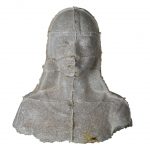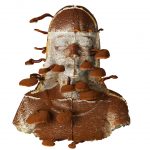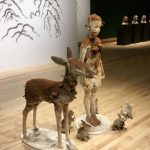Xiaojing Yan

A surge of post-colonial hybridity has given rise to objects that at first glance appear somewhat different and unrecognizable—creating a new cultural arena for the negotiation of meaning and representation. According to cultural theorist Homi K. Bhabha, this intermingling is more than a synthesis between a cultural origin and its present identity to form a third representation; rather, it is a displacement of the two original moments to create a “third space,” enabling other structures, positions, and political initiatives to emerge, allowing for new narratives, wisdoms, and ways of thinking.
This third space also brings forth a sense of “otherness,” which results in awareness of being in between spaces where identities no longer constitute a sense of social belonging and pre-existing ways of interpretation. The art practice of Xiaojing Yan brings forth enchanting insight into this occurrence—focusing on issues of longevity, cultural transference, and the illusion of self as reflected in folktales and legends.
In 2019 I had the pleasure to present a solo exhibition of the work of Xiaojing Yan entitled Heaven and Earth. The exhibition combined sheer silk panels embedded with dried pine needles with a series of sculptures made from cultivated lingzhi mushrooms. The dialogue between the works created a surreal atmosphere where childhood memories and present-day reality collide. Viewers were left to question their own cultural beliefs on the meaning of existence.
Since her exhibition, I have continued to follow and marvel at the direction and progression of Yan’s art practice. Her mixed-media installations and large-scale paintings reflect an artist who enjoys the wonder of experimentation and the challenge of pushing boundaries. After a recent studio visit, I found her metaphorical references to her Chinese ancestral past in combination with her love of scientific exploration the most fascinating aspect in her ever-evolving art practice.
As a child growing up in Jiangsu Province north of Shanghai, Yan was immersed in Buddhist and Daoist mythology and folklore. Stories of immortality, reincarnation, and the human connection to the natural world fueled her imagination. Throughout these stories, the lingzhi mushroom played an important role in symbolizing good fortune, longevity, and mysticism. With its delicate curves and sculptural form, the lingzhi is a popular botanical motif and pattern used in Chinese drawings, paintings, textiles, and architectural design.
Now based in Toronto, Yan continues to embrace these Chinese legends and give a new hybrid interpretation of the magical lingzhi mushroom. After several years of experimentation, Yan has successfully perfected the germination of mycelium (the network of cells that branches out from a fungus) to cultivate beautiful sculptural forms. Working in a temperature-controlled climate, Yan infuses her wood-chip armatures with lingzhi spores which over time transform into sculptural organisms that speak to rebirth and rejuvenation.
For example, in her ongoing series Lingzhi Girl (2016–present) and Far From Where You Divined (2017–present), we see how Yan’s technical advancements have blossomed into an intriguing transformative sculptural process. Each of the sixteen busts of the Lingzhi Girl are unique in structure, yet all display a cocoa powder-like dusting of spores on its surface. A direct result of the cultivation process, it creates an interesting illusion of terracotta texture and colour—triggering an association with the terracotta warriors from the mausoleum of the first Qin emperor of China. A play perhaps on the empirical obsession with power and immortality. Or maybe a subtle self-reflective reference to Yan’s childhood stories of strong female protagonist in Chinese folklore and the now empowered Western woman that the artist herself has become.
In Far From Where You Divined, the lingzhi sculptures move from human to animal forms. Yan chooses to represent deer and rabbits, both iconic symbols in Western and Eastern storytelling. From the confident White Rabbit in Alice in Wonderland and the mystical White Stag in Narnia to the Jade Rabbit and the beautiful four-antlered Fuzhu deer in Chinese mythology, Yan invites viewers to hover between her two worlds of imagination to echo the power of cultural adaption.
Yan’s blending between East and West, human and animal, and scientific and holistic in her art practice creates a cultural hybridity or “otherness” that is mesmerizing. She bridges her past with the present and possibly the future to bring viewers into an ephemeral world where memories and personal experience metamorphose into new ways of seeing and understanding.
Artist

Xiaojing Yan is a Chinese Canadian artist working and living in Markham, Ontario Canada. She received a B.F.A. from Nanjing University of the Arts, China in 2000; and an M.F.A. from Indiana University of Pennsylvania, USA in 2007. She has been included in solo and group exhibitions internationally, including the Royal Ontario Museum, Canada and the Suzhou Museum, China. Her work has been collected by many museums, institutions and private collectors. She has created many public art projects in Canada and China. She is also a recipient of numerous grants and awards,including the 2014 Outstanding Young Alumni Award from Indiana University of Pennsylvania, Project Grant from the Canadian Council for the Arts, the Chalmers Arts Fellowship, and Mid-career Grant from Ontario Arts Council.
Links
Website: https://yanxiaojing.com/
~ Posted by Suzanne Luke







